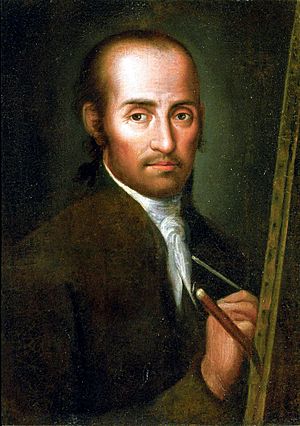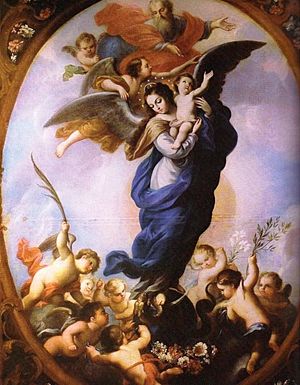José de Ibarra facts for kids
José de Ibarra (1688–1756) was an important painter from New Spain, which is now Mexico. He was born in Guadalajara in 1688 and passed away in Mexico City in 1756.
Ibarra learned from a well-known painter named Juan Correa. Along with Juan Rodríguez Juárez, José de Ibarra was one of the most famous painters in New Spain during the early 1700s. He followed new art styles that were popular in Italy and France. His work helped prepare the way for another very famous painter, Miguel Cabrera.
Ibarra's Artistic Journey
For a long time, some art historians didn't fully appreciate Ibarra's work. A historian named Manuel Toussaint even suggested that Ibarra's art showed a "decline" in Mexican painting. This was partly because Ibarra's style was compared to the Spanish painter Bartolomé Esteban Murillo.
However, in recent years, experts have looked at José de Ibarra's paintings again. Researchers like Rogelio Ruiz Gomar and Ilona Katzew have shown how important and original his art truly was. They highlight his consistent quality and how his work helped change art in New Spain. This change eventually led to the creation of the Royal Academy of San Carlos of the Noble Arts.
Ibarra's paintings are known for several special qualities:
- His brushstrokes were light and free.
- He created unique and expressive faces.
- His compositions were well-balanced and symmetrical.
- He carefully studied how the human body looked.
- He was great at showing strong differences in light and shadow.
- He used fewer colors, making his paintings stand out.
- The people in his paintings often had very clear expressions.
Famous Works and Legacy
José de Ibarra created many paintings. Some of his most famous works are portraits of important leaders. These include the viceroys Pedro de Cebrián and Agustín and Pedro de Castro Figueroa y Salazar. He also painted the Archbishop of Mexico, Juan Antonio de Vizarrón y Eguiarreta. These portraits show how skilled he was at painting people. You can see some of them at the National Museum of History in Mexico.
He also painted for churches and religious buildings. For example, he created canvases for the "Relicario de San José" in the old Jesuit college of Tepotzotlán. This building is now the National Museum of Viceroyalty. These paintings show scenes like the Flight to Egypt.
Ibarra also made a series of paintings for the Puebla Cathedral. These include four large paintings called "Adorations" and paintings for the "Way of the Cross." For a long time, some of these were thought to be by Miguel Cabrera.
Ibarra strongly supported the idea that painting was a serious art form. He was influenced by other artists of his time, like Cristóbal de Villalpando and Juan Rodríguez Juárez.
Many of Ibarra's artworks are kept in museums across Mexico. You can also find his paintings in the Mexico City Metropolitan Cathedral. He was one of the most active painters of his time, mostly creating religious art for cathedrals in Mexico.
His remains are buried at the Church of Santa Inés in Mexico City.
Gallery
See also
 In Spanish: José de Ibarra para niños
In Spanish: José de Ibarra para niños
- Mexican art




